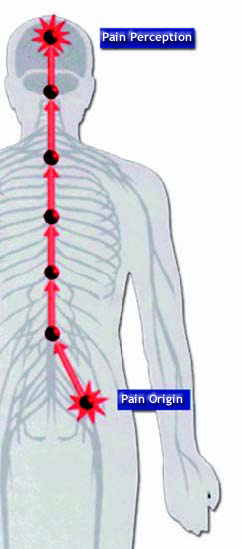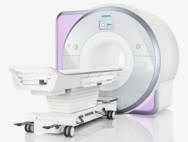|
|
|
 |
Definition of pain
The International Association for the Study of Pain
(IASP) gives the following definition:
Pain is ‘an unpleasant sensory and emotional experience
associated with actual or potential tissue damage, or
described in terms of such damage’.
 |
| Figure 1: Origin of pain and pain perception |
|
 |
Types of pain
The cause of pain can be non-malignant or cancerous
(malignant). Pain is classified according to the source
of injury:
● Neuropathic – injury to tissue of the nervous system
● Nociceptive – injury to tissue other than nerve tissue |
 |
Neuropathic pain
Neuropathic pain is defined as pain initiated or caused
by a primary lesion or dysfunction in the peripheral or
central nervous system. Neuropathic pain is described as
a ‘burning’, ‘tingling,’ ‘shooting’, ‘electric-like’ or
‘lightning-like’ pain. Neuropathic pain may persist for
months or years beyond the apparent healing of any
damaged tissues.
Neuropathic pain is commonly associated with several
distinct characteristics. The first is unfamiliar or
abnormal unpleasant sensations such as ‘lancing’ or
‘burning’ pain, which are called dysesthesias.
Persistent allodynia, pain resulting from a non-painful
stimulus such as light touch, is also a common
characteristic of neuropathic pain. Partial sensory
deficit, for example, diminished perception of certain
stimuli such as heat or cold, is also seen in patients
with neuropathic pain. Finally, neuropathic pain is
characterized by hyperpathia, which occurs when the pain
message from a normally painful event is exacerbated so
that greater pain is felt. Neuropathic pain can be
effectively treated with neurostimulation |
 |
Nociceptive pain
Nociceptive pain is caused by an acute tissue injury or
disease outside of the nervous system. It is often an
on-going ‘dull ache’ or ‘pressure’, rather than the
sharper, trauma-like pain more characteristic of
neuropathic pain.
Examples of nociceptive pain include sprains, bone
fractures, burns, bumps, bruises, postoperative pain,
and inflammation from an infection or arthritic
disorder. Nociceptive pain can be effectively treated
with intrathecal drug delivery
There are two types of nociceptive pain (Table 1):
● Somatic nociceptive pain
● Visceral nociceptive pain
|
Table 1: Differences between
somatic and visceral nociceptive pain |
| Somatic
nociceptive pain |
Visceral
nociceptive pain |
| Location |
Localized |
Diffuse |
| Sensation |
Continuous, aching,
throbbing and gnawing |
Deep, continuous, dull
and vague |
| Cause |
Destruction, invasion,
or irritation of skeletal muscles, tissue, bone
and blood vessels |
Injury to the viscera
such as internal organs of the cardiovascular
and respiratory system, the gastrointestinal
tract and the reproductive and urinary tracts |
|
|
|
|
|
 What’s Up
What’s Up |
 |
August/14/2007
Inomed ISIS Intraoperative neurophysiological monitoring started
to function in all our related surgeries.
|
|
|
|
 |
Oct /07/2009
The author celebrating 30 years experience in neurosurgery. |
 |
Nov/28/2013
Skyra 3 tesla magnetom with all clinical applications are
running in the neurosuite. |
|
|
